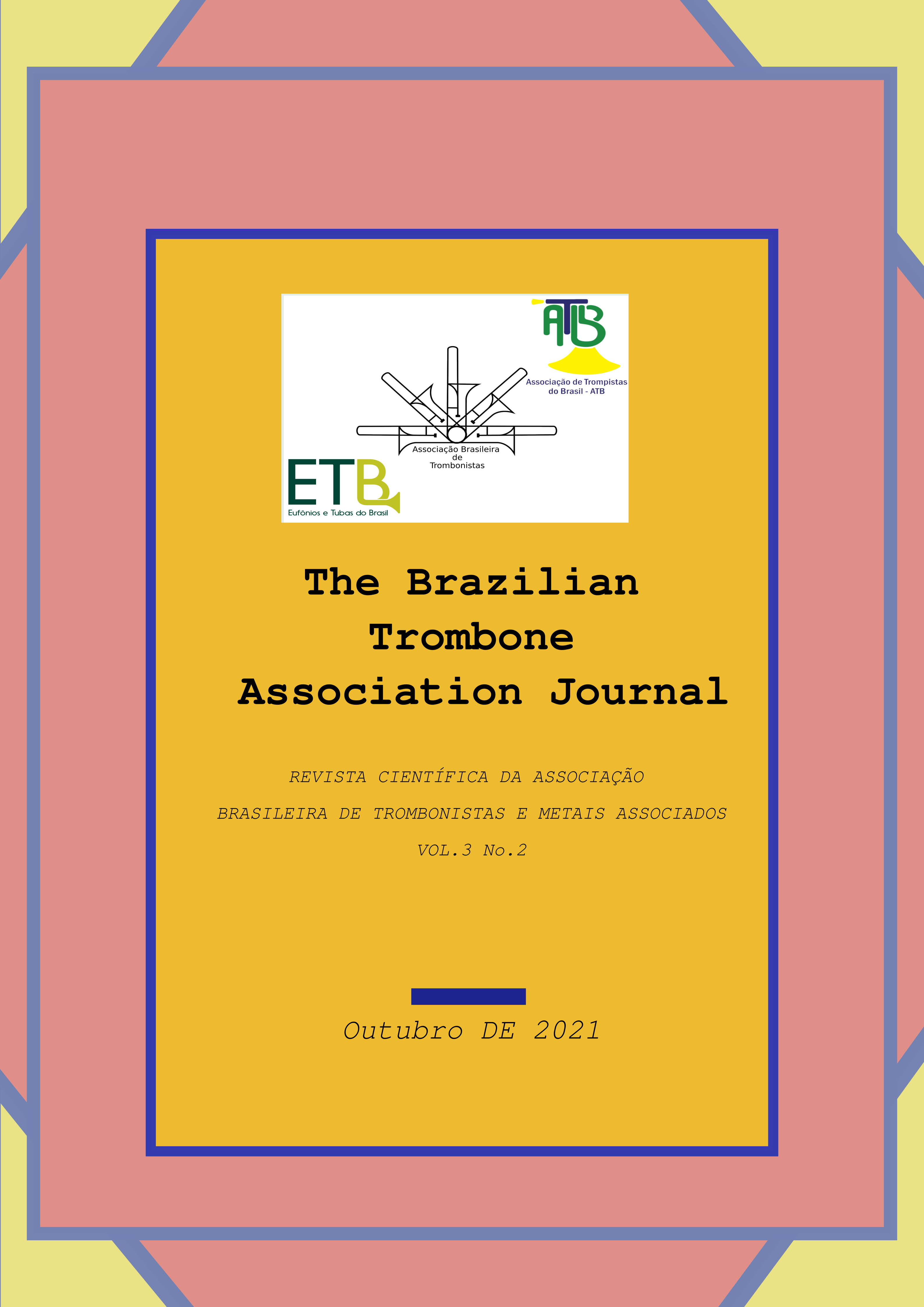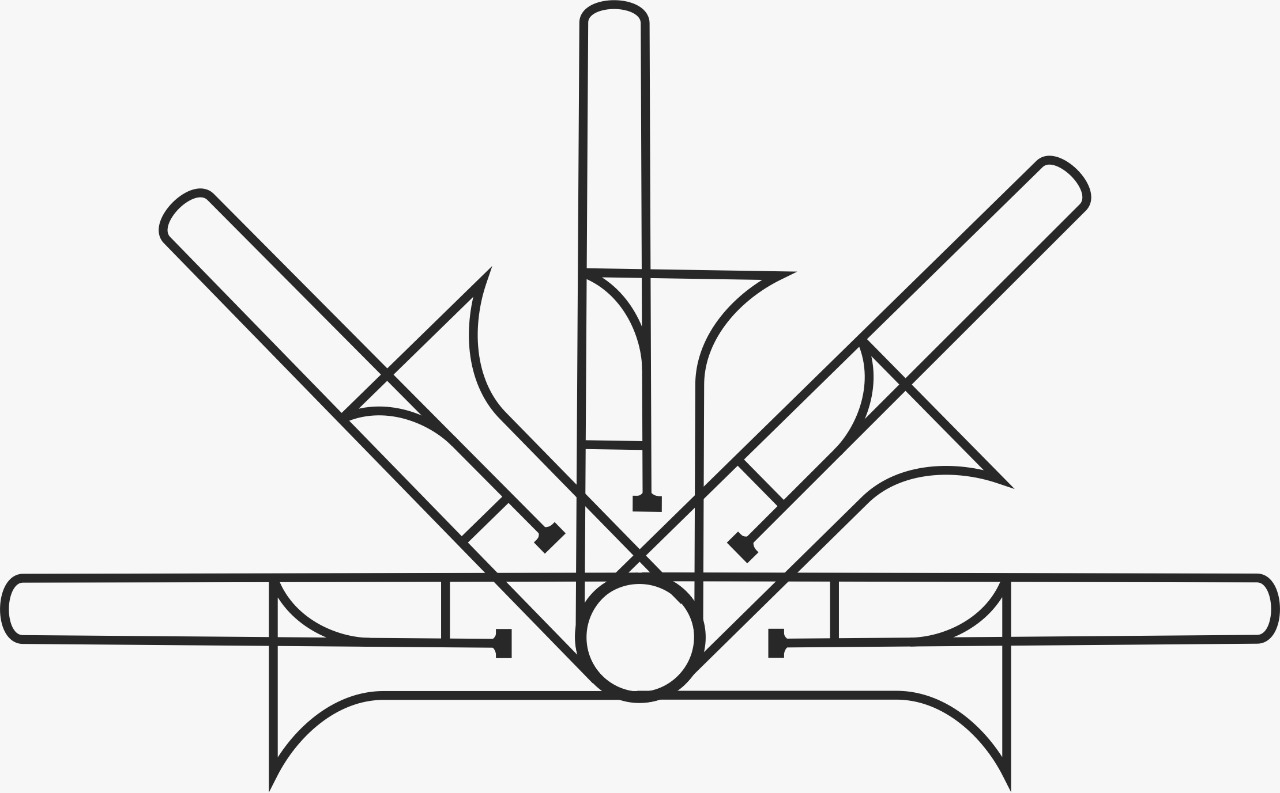Problemas de saúde em musicistas com ênfase na família dos metais
uma revisão da literatura
Keywords:
Musical instruments; Occupational problems in musicians; musician's health.Abstract
The musicians’ health, when compared to the athletes’ health, is something that needs much investigation and deepening, given the production in the field of sports science. This review proposes to raise the main evidence on the subject, bringing contributions to the health of musicians, especially wind/brass players. The themes were divided into two major blocks: a) physical/somatic problems; b) psychological problems. In both cases the incidence depends, among other factors, on the level of exposure and intensity to which each subject is exposed. Musculoskeletal discomforts and performance anxiety are by far the most prevalent in each block, affecting about 50% and 20% of individuals, respectively. The teaching-learning environment should generate conditions for this process to take place in a protective and optimized way in relation to the use of time and all issues involving the training strategic planning. Regarding the professional routine, especially in institutions, it would be ideal to have the continuous participation of professionals who could contribute to a better physical and psychological preparation of the musicians, as well as in the early detection of signs and symptoms suggestive of occupational problems, as already occurs in high performance sports.
Downloads
References
BOUHUYS, A. Physiology and musical instruments. Nature, v. 221, p. 1199–1204, 1969.
CHAN, C.; ACKERMANN, B. Evidence-informed physical therapy management of performance-related musculoskeletal disorders in musicians. Frontiers in Psychology, v. 5, p. 1-14, 2014.
CRUDER, C. et al. Profiling the location and extent of musicians’ pain using digital pain drawings. Pain Practice, v. 18, n. 1, p. 53-66, 2018.
DAVID, S.; et al. Spontaneous cervicothoracic epidural hematoma following prolonged Valsalva secondary to trumpet playing. The American Journal of Emergency Medicine, v. 15, n. 1, p. 73-75, 1997.
DÉTÁRI, A. et al. Psychosocial Work Environment Among Musicians and in the General Workforce in Norway. Frontiers in Psychology, v. 11, p. 1-11, 2020.
FIZ, J. A.; et al. Maximum respiratory pressures in trumpet players. CHEST, v. 1104, n. 4, p. 1203-4, 1993.
FLORES-FRANCO, R. A.; LIMAS-FRESCAS, N. E. The overused airway: lessons from a young trumpet player. Medical Problems of Performing Artists, v. 25, n. 1, p. 28-35, 2010.
FRUCHT, S. J. Embouchure dystonia: a video guide to diagnosis and evaluation. Journal of Clinical Movement Disorders, v.3, n. 10, p. 1-4, 2016.
GAMBICHLER, T.; BOMS, S.; FREITAG, M. Contact dermatitis and other skin conditions in instrumental musicians. BMC Dermatol, v. 4, n. 3, p. 1-12, 2004.
GŁOWACKA, A.; et al. The impact of the long-term playing of musical instruments on the stomatognathic system - review. Adv Clin Exp Med, v. 23, n. 1, p. 143-6, 2014.
GUNST, V.; et al. Playing wind instruments as a potential aetiologic cofactor in external cervical resorption: two case reports. International Endodontic Journal, v. 44, p. 268-82, 2011.
GÜZEL, A.; et al. Spontaneous spinal epidural hematoma after seizure: a case report. Clinical Pediatrics, v. 46, n. 3, p. 263-5, 2007.
ITO, S; et al. A case of spontaneous pneumomediastinum in a trombonist. Respiration & Circulation, v. 37, p. 1359-1362, 1989.
JUE, M. S.; KIM, Y. S.; RO, Y. S. Fiddler’s neck accompanied by allergic contact dermatitis to nickel in a viola player. Ann Dermatol, v. 22, n. 1, p. 88-90, 2010.
KOK, L. M.; et al. The occurrence of musculoskeletal complaints among professional musicians: a systematic review. Int Arch Occup Environ Health, v. 89, p. 373-396, 2016.
KOZAKEVICH, G. V.; DA SILVA, R. M. Tuberculose: revisão de literatura. Arq. Catarin Med., v. 44, n 4, p. 34-47, 2015.
KYUNG, S. K.; et al. Head-neck and mediastinal emphysema caused by playing a wind instrument. European Annals of Otorhinolaryngology - Head and Neck Diseases, v. 127, n. 6, p. 221-3, 2010.
LINDHORST, E; PAOLUCCI, V. Saxophone spermatic cord hematoma. Am J Emerg Med, v. 18, n. 4, p. 504-5, 2000.
LODHA, S.; SANTA, M.; SHARMA, P. Hypersensitivity Pneumonitis in a Saxophone Player. Chest Journal, v. 93, n. 6, p. 1322, 1988.
LOPES E PÊGO, F. P.; PÊGO, D. R. Síndrome de Burnout. Rev Bras Med Trab., v. 14, n. 2, p. 171-6, 2016.
LUACES, R.; et al. Pneumoparotid: a case report and review of the literature. Oral and Maxillofacial Surgery, v. 66, n. 2, p. 362-5, 2008.
MACIA, I.; et al. Spontaneous pneumomediastinum: 41 cases. European Journal of Cardio-thoracic Surgery, v. 31, p. 1110-4, 2007.
METE, A.; et al. Dynamic changes in optic disc morphology, choroidal thickness, anterior chamber parameters, and intraocular pressure during Valsalva maneuver. Arq Bras Oftalmol., v.79, n. 4, p. 209-13, 2016.
METERSKY, M. L.; et al. Trombone player's lung a probable new cause of hypersensitivity pneumonitis. Chest Journal, v. 138, n. 3, p. 754-756, 2010.
METZGER, F.; et al. Hypersensitivity Pneumonitis Due to Molds in a Saxophone Player. Chest Journal, v. 138, n. 3, p. 724-726, 2010.
MURPHY, J.; et al. Allergic contact dermatitis from colophony and compositae in a violinist. Contact Dermatitis, v. 40, n. 6, p. 334, 1999.
OKOSHI, K. et al. Musical instrument-associated health issues and their management. Tohoku J. Exp. Med., v. 243, p. 49-56, 2017.
ORZEL, H. Undergraduate music student stress and Burnout. Dissertação (Mestrado em Música) - The Faculty of the School of Music and Dance, San José State University. San José/Califórnia, p. 67. 2010.
OSBORNE, M. S.; GREENE, D. J.; IMMEL, D. T. Managing performance anxiety and improving mental skills in conservatoire students through performance psychology training: a pilot study. Psychology of Well-Being: Theory, Research and Practice, v. 4, n. 18, p. 1-17, 2014.
POURYAGHOUB, G.; MEHRDAD, R.; POURHOSEIN, S. Noise-induced hearing loss among professional musicians. J Occup Health, v. 59, p. 33-7, 2017.
PRASAD, K.C., VIJAYALAKSHMI, S.; PRASAD, S.C. Laryngoceles: presentations and management. Indian J Otolaryngol Head Neck, S 60, p. 303-8, 2008.
PRICE, K.; SCHARTZ, P.; WATSON, A. H. D. The effect of standing and sitting postures on breathing in brass players. SpringerPlus, v. 210, n. 3, p. 1-17, 2014.
_________, WATSON, A. H. D. Postural problems of the left shoulder in an orchestral trombonist. Work, v. 40, n. 3, p. 317-24, 2011.
RACKLEY, C. R.; MELTZER, E. B. Throw Caution to the Wind Instruments. Chest Journal, v. 139, n. 3, p. 729, 2011.
ROCHA, Sérgio. Musical Performance Anxiety (MPA). In: KALININ, Vladimir; HOCAOGLU, Cicek; MOHAMED, Shafizan. Anxiety Disorders: The New Achievements. London: IntechOpen, 2021. (53)-(66).
SANTUCCI, M. Protecting musicians from hearing damage: a review of evidence-based research. Medical Problems of Performing Artists, v. 24, n. 3, p. 103-7, 2009.
SAUNDERS, H. F. Wind parotitis. The New England Journal of Medicine, v. 289, n. 13, p. 698, 1973.
SCHINK, T.; et al. Incidence and relative risk of hearing disorders in professional musicians. Occup Environ Med, v. 71, p. 472-6, 2014.
SCHMIDTMANN, G.; et al. Intraocular pressure fluctuations in professional brass and woodwind musicians during common playing conditions. Graefes Arch. Clin. Exp. Ophthalmol., v. 249, p. 895-901, 2011.
SCHUMAN, J. S.; et al. Increased intraocular pressure and visual field defects in high resistance wind instrument players. Ophthalmology, v. 107, p. 127-133, 2000.
SIHOTA, R.; et al. Does an iridotomy provide protection against narrowing of the anterior chamber angle during Valsalva maneuver in eyes with primary angle closure. Eye (Lond), v. 22, p. 389-393, 2008.
STANHOPE, J. et al. Have musicians’ musculoskeletal symptoms been thoroughly addressed? A systematic mapping review. International Journal of Occupational Medicine and Environmental Health, v. 32, n. 3, p. 291-331, 2019.
___________, J. et al. How do we assess musician’ musculoskeletal symptoms?: a review of outcomes and tools used. Insdustrial Health, v. 57, p. 454-494, 2019.
STELL, P. M.; MARAN, A. G. D. Laryngocoele. The Journal of Laryngology & Otology, v. 89, n. 9, p. 915-924, 1975.
STRMER, C.C.; et al. Hearing loss and tinnitus in rock musicians: a Norwegian survey. Noise Health, v.17, p 411-21, 2015.
TERMSARASAB, P.; FRUCHT, S. J. Evaluation of embouchure dysfunction: experience of 139 patients at a single center. Laryngoscope, v. 126, p. 1327–1333, 2016.





